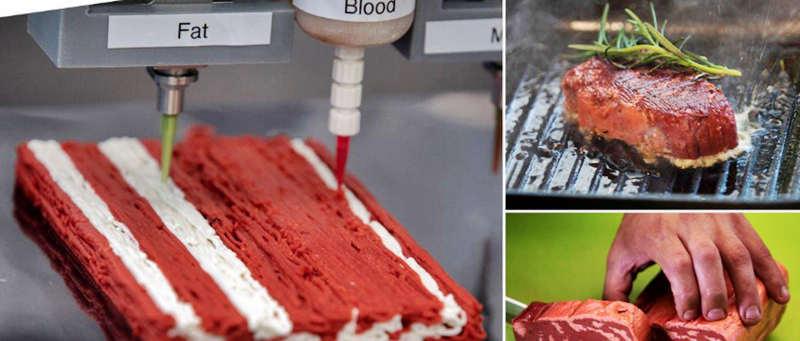A factory in Holland prints 500 tons of lab steaks per month through 3D printers.

By ChatGPT - Human Synthesis - 06 Feb. 2024. Origin German News.:
Around 110 German restaurants are already buying "meat" from Redefine Meat. To begin the process of 3D-pressed meat, scientists biopsy a sample charge of animal stem cells depending on the desired type of meat: beef, pork, poultry, or even fish.
These cells are then subjected to a proliferation process and are immersed in a nutrient-dense serum in a climate-controlled bioreactor. Over several weeks, these cells multiply, interact, and differentiate in the fat and muscle cells that make up the bioink. This is how a robot arm uses a nozzle to spread this filament of baked meat over each other in thin layers.
The arm follows the instructions of an uploaded digital file with computer-aided design software or CAD to replicate the correct shape and structure of the desired meat. The 3D-printed meat material must be viscose but solid enough to achieve a full structural model of accurate vascularization of tissue depending on the type and cut of meat. Enjoy your meal!
Whoever thinks that all this is not true should quickly take off his glasses to look clearly into his environment. Because also in the country of Brandenburg, on the outskirts of Berlin (by the way, also with Chinese companies) the first such producer will come on the market and they are already advertising it in the public media, such as on Saturday on BB-Radio.
ChatGPT
Lab-grown meat, also known as cultured or cultivated meat, is indeed a real and emerging technology in the food industry. While the process you described might not be entirely accurate or representative of every lab-grown meat production method, the general concept is correct.
Lab-grown meat involves taking a small sample of animal cells (often stem cells) and proliferating them in a lab setting, providing the necessary nutrients for them to grow and differentiate into muscle and fat cells. This process usually takes a few weeks to produce a usable amount of meat.
The idea behind lab-grown meat is to provide a more sustainable and ethical alternative to traditional animal farming. It requires significantly fewer resources such as land, water, and feed, and eliminates the need for raising and slaughtering animals. Additionally, it can potentially reduce the environmental impact and ethical concerns associated with animal agriculture, such as greenhouse gas emissions and animal welfare issues.
While lab-grown meat is still in the early stages of development and production, there has been growing interest and investment in the technology. Several companies around the world are working on bringing lab-grown meat products to market, and some have already achieved regulatory approval for limited sales.
As with any new technology, there are both proponents and skeptics. Some people are excited about the potential benefits of lab-grown meat, while others have concerns about its safety, taste, and potential long-term impacts on traditional farming communities.
In conclusion, while lab-grown meat may seem like science fiction to some, it is a real and evolving technology that has the potential to transform the way we produce and consume meat in the future.
If Redefine Meat or other companies are supplying lab-grown meat to German restaurants, it would likely be marketed as a sustainable and ethical alternative to traditional meat. These restaurants might emphasize the environmental benefits of lab-grown meat, such as reduced greenhouse gas emissions and land use compared to conventional livestock farming.
The restaurants serving lab-grown meat would likely target environmentally conscious consumers who are interested in trying innovative and sustainable food options. They might also cater to vegetarians and vegans who miss the taste and texture of meat but are unwilling to consume animal products.
Given Germany's reputation for innovation and sustainability, it wouldn't be surprising to see some restaurants in the country embrace lab-grown meat as part of their menu offerings. However, widespread adoption may still be limited by factors such as cost, consumer acceptance, and regulatory approval.
As the technology continues to develop and become more affordable, we may see a greater presence of lab-grown meat in restaurants around the world, including Germany.
The taste of lab-grown meat is designed to be as similar as possible to conventional animal meat. The goal of the technology is to replicate the taste, texture, and appearance of traditional meat products, so consumers have a familiar eating experience.
Lab-grown meat is produced from animal cells, so it contains the same proteins and nutrients found in conventional meat. However, because it is grown in a controlled environment, there may be slight differences in flavor and texture compared to meat from animals raised on farms.
Some early taste tests and consumer feedback suggest that lab-grown meat can be very similar to conventional meat in terms of taste and texture. However, as technology continues to develop and improve, lab-grown meat products will likely become even more indistinguishable from traditional meat.
Ultimately, the taste of lab-grown meat may vary depending on factors such as the specific production methods used, the type of cells used, and any added flavorings or seasonings. However, the goal of the technology is to create a product that is virtually indistinguishable from conventional meat, so consumers can enjoy the taste of meat while also supporting sustainability and ethical concerns.
In conclusion, while lab-grown meat is still a relatively new technology, it holds great promise for providing a sustainable and ethical alternative to traditional animal farming. The process involves growing meat from animal cells in a lab setting, to replicate the taste, texture, and appearance of conventional meat products.
While there may be slight differences in taste and texture compared to meat from animals raised on farms, the goal is to create a product that is virtually indistinguishable from traditional meat. Early taste tests and consumer feedback suggest that lab-grown meat can indeed resemble conventional meat closely.
As the technology continues to develop and become more affordable, we may see greater adoption of lab-grown meat in restaurants and supermarkets around the world. This could have significant benefits for the environment, animal welfare, and human health. However, challenges such as cost, consumer acceptance, and regulatory approval still need to be addressed for widespread adoption to occur.
Overall, lab-grown meat represents an exciting opportunity to revolutionize the way we produce and consume meat, offering a more sustainable and ethical option for feeding the growing global population.
